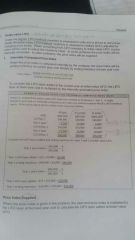![]()
![]()
![]()
Use LEFT and RIGHT arrow keys to navigate between flashcards;
Use UP and DOWN arrow keys to flip the card;
H to show hint;
A reads text to speech;
19 Cards in this Set
- Front
- Back
- 3rd side (hint)
|
Types of inventories held for resale |
1) Retail: finished goods only And Manufacturing: 2) raw materials 3) Work in Process 4) Finished goods |
|
|
|
F.O.B Shipping Point |
Buyer pays for shipping costs, "freight in" is added to cost of inventory. Becomes the buyer's inventory (title passes) as soon as seller delivers goods to the common carrier |
|
|
|
F.O.B Destination |
Seller pays for shipping, "freight out" selling expense. Seller's inventory, title passes only once the buyer receives the goods from the common carrier. |
|
|
|
Sales w/ right to return |
Gen. Rule: goods are sold but buyer has the right to return, goods are still included in the seller's inventory. IF the amount of returns can be reasonably estimated, transaction is recorded as a sale with an allowance for estimated returns |
|
|
|
Consigned Goods |
Title never passes to the consignee, just a sales agent/middle man. Title passes once all criteria of a sale is met and delivered to a third party buyer. The consignor (seller) are the "true owners" until sale is made because title and risk of loss have not been transferred. Shipping costs to consignee are included in consignor's inventory costs. |
|
|
|
Valuation of inventory, Gen Rule |
U.S GAAP requires inventory to be stated at cost where evidence indicates costs will be recovered with a normal profit on a sale in the ordinary course of business. |
|
|
|
Valuation of inventory, exception - departure from cost basis |
When the utility of goods (selling price) becomes less than their costs, inventory can then be valued at either the lower of cost or market, or lower of cost or NRV. This is done to show the probably loss sustained (conservatism) in the period in which occured (matching principle) |
|
|
|
Write-down of inventory |
U.S GAAP- write-down is usually reflected in COGS, unless the amount is material then the loss should be identified separately on the I.S IFRS does not specify where an inventory write-down should be reported on the I.S |
|
|
|
Reversal of Inventory write-downs |
U.S GAAP- reversals of inventory write-downs are prohibited. IFRS allows the reversal of inventory write-downs, but limited to the amount of the original write-down. It is recorded as a reduction of the total inventory costs in the period of reversal. |
|
|
|
ASU 2015-11 |
Inventory costed using LIFO or the retail inventory method should be measured at the lower of cost or market. All inventory not costed using LIFO or retail method should be measured at the lower of cost or NRV. |
|
|
|
Lower of cost or market |
U.S GAAP only. Used for inventories costed using LIFO or retail method. May be applied to single item(most conservative), a category, or total inventory. Market value is the middle value of the - Replacement cost (by purchase or reproduction) - Market ceiling (NRV = net selling price less the costs to complete and dispose) - Market floor (market ceiling less normal profit margin) The middle value is then compared to original cost. |
|
|
|
Lower of Cost and NRV |
IFRS and U.S GAAP. All inventories not costed with LIFO or retail method. May be applied to a single item, category, or total inventory. NRV= selling price less costs to complete/dispose (same as "market ceiling") |
|
|
|
Periodic Inventory System (method) |
Units of inventory and associated costs are counted & valued at the END of the period. COGS is a plug figure. COGS = Beg. Inv. + purchases - End. Inv. Does not keep a running balance. End. Inv is physically counted. |
|
|
|
Perpetual Inventory System (method) |
Keeps a running total of inventory balances by updating the inventory and related COGS records with each purchase and sale. |
|
|
|
FIFO method |
First costs inventoried and first transferred to COGS. End. Inv. Includes most recently incurred costs and therefore approximates replacement cost. During period of rising prices, FIFO has highest end inv, lowest COGS, and highest net income. End inv and COGS are the same using FIFO periodic/perpetual method. |
|
|
|
Weighted Average method |
Suitable for homogeneous products and a periodic inventory system. Average cost of each item in inventory = weighted average of costs of all items in inventory. Weighted avg = total costs of inv available/ total # of units available |
|
|
|
Moving average method |
Computes weighted avg cost after each purchase: total cost of inventory available (inventory + current purchase) / total units available after purchase. Perpetual system is necessary to use moving avg. |
|
|
|
LIFO method |
US GAAP ONLY last costs inventoried are first costs tranferred to COGS. Ending inventory includes the oldest costs (not approximate replacement cost) If used for tax purposes, must also be used in GAAP financial statements. Unlike FIFO, LIFO periodic does not equal LIFO perpetual. |
|
|
|
Dollar-value LIFO |
Estimate of change in price levels required. At Dollar-value LIFO = Price index (supplied or internally generated) x base year cost of LIFO layer added. Internally generated price index = end inv @ current year cost/ end inv @ base yr cost |

|

